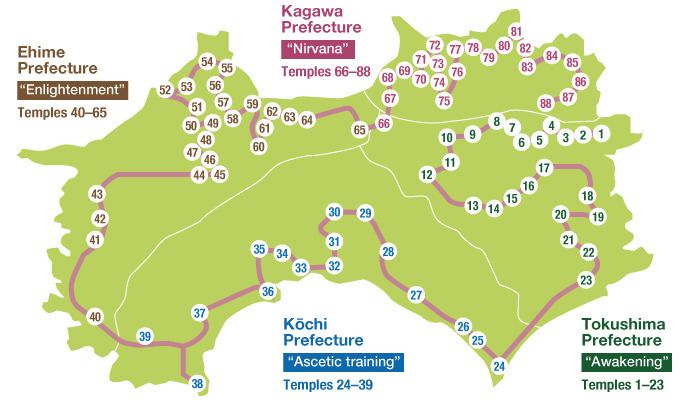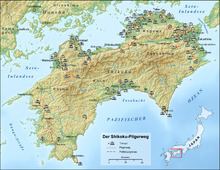 | ||
Shikoku pilgrimage documentary part 1
The Shikoku Pilgrimage (四国遍路, Shikoku Henro) or Shikoku Junrei (四国巡礼) is a multi-site pilgrimage of 88 temples associated with the Buddhist monk Kūkai (Kōbō Daishi) on the island of Shikoku, Japan. A popular and distinctive feature of the island's cultural landscape, and with a long history, large numbers of pilgrims (known as henro (遍路)) still undertake the journey for a variety of ascetic, pious, and tourism-related purposes. The pilgrimage is traditionally completed on foot, but modern pilgrims use cars, taxis, buses, bicycles, or motorcycles. The standard walking course is approximately 1,200 kilometres (750 mi) long and can take anywhere from 30 to 60 days to complete.
Contents
- Shikoku pilgrimage documentary part 1
- Background
- Kb Daishi
- Development
- Stages
- Equipment
- Rites
- Imitative versions
- Temples
- References

In addition to the 88 "official" temples of the pilgrimage, there are over 20 bangai — temples not considered part of the official 88. To complete the pilgrimage, it is not necessary to visit the temples in order; in some cases it is even considered lucky to travel in reverse order. Henro (遍路) is the Japanese word for pilgrim, and the inhabitants of Shikoku call the pilgrims o-henro-san (お遍路さん), the o (お) being an honorific and the san (さん) a title similar to "Mr." or "Mrs.". They are often recognizable by their white clothing, sedge hats, and kongō-zue or walking sticks. Alms or osettai are frequently given. Many pilgrims begin and complete the journey by visiting Mount Kōya in Wakayama Prefecture, which was settled by Kūkai and remains the headquarters of Shingon Buddhism. The 21 kilometres (13 mi) walking trail up to Koya-san still exists, but most pilgrims use the train.

Background

Pilgrimages have played an important part in Japanese religious practice since at least the Heian period. Typically centred upon holy mountains, particular divinities, or charismatic individuals, they are usually to Buddhist sites although those to the shrines of Kumano and Ise are notable exceptions.
Kōbō Daishi

Kūkai, born at Zentsū-ji (Temple 75) in 774, studied in China, and upon his return was influential in the promotion of esoteric Buddhism. He established the Shingon retreat of Kōya-san, was an active writer, undertook a programme of public works, and during visits to the island of his birth is popularly said to have established or visited many of its temples and to have carved many of their images. He is posthumously known as Kōbō Daishi.
Development

The legends and cult of Kōbō Daishi, such as the episode of Emon Saburō, were maintained and developed by the monks of Kōya-san who travelled to expound Shingon and were active, along with other hijiri, in Shikoku. In the Edo period, the policy of tochi kinbaku (土地緊縛) restricted and regulated the movement of ordinary people. Pilgrims were required to obtain travel permits, follow the main paths, and pass through localities within a certain time limit, with the book of temple stamps or nōkyō-chō helping to provide proof of passage.
Stages
Shikoku literally means "four provinces", those of Awa, Tosa, Iyo, and Sanuki, reorganised during the Meiji period into the prefectures of Tokushima, Kōchi, Ehime, and Kagawa. The pilgrim's journey through these four provinces is likened to a symbolic path to enlightenment, with temples 1–23 representing the idea of awakening (発心, hosshin), 24–39 austerity and discipline (修行, shugyō), 40–65 attaining enlightenment (菩提, bodai), and 66–88 entering nirvana (涅槃, nehan).
Equipment
The pilgrim's traditional costume comprises a white shirt (白衣, oizuru), conical Asian hat (すげ笠, suge-kasa), and kongō-zue (金剛杖). This may be supplemented by a wagesa (輪袈裟). The henro also carries a bag (ずだ袋, zuda-bukuro) containing name slips (納札, osame-fuda), prayer beads (数珠, juzu) (also known as nenju (念珠)), a nōkyō-chō (納経帳) to collect shuin (朱印), incense sticks (線香, senkō), and coins used as offerings (お賽銭, o-saisen). The more religiously-minded henro may also carry a book of sutras (経本, kyōbon) and go-eika (ご詠歌) set with a bell.
Rites
Upon arrival at each temple the henro washes before proceeding to the Hondō. After offering coins, incense, and the osame-fuda, the Heart Sutra (般若心経, Hannya Shingyō) is chanted along with repetition of the Mantra of the main image (本尊, honzon) and the Mantra of Light (光明真言, Kōmyō Shingon). After kigan and ekō prayers, the henro proceeds to the secondary temple (大師堂, Daishidō). Coins and a fuda are similarly offered, and again the Heart Sutra is chanted, along with repetition of the Gohōgō Mantra, namu-Daishi-henjō-kongō.
Imitative versions
Attesting to the popularity of the Shikoku pilgrimage, from the eighteenth century a number of smaller imitative versions have been established. These include a 150 kilometres (93 mi) circuit on Shōdo Island northeast of Takamatsu; a 3 kilometres (1.9 mi) course on the grounds of Ninna-ji in Kyoto; a route on the Chita Peninsula near Nagoya; and circuits in Edo and Chiba Prefecture. Outside Japan, another version is on the Hawai'ian island of Kaua'i.
Temples
Collectively, the 88 temples are known as Shikoku Hachijūhakkasho (四国八十八箇所) or simply the Hachijūhakkasho (八十八箇所).
